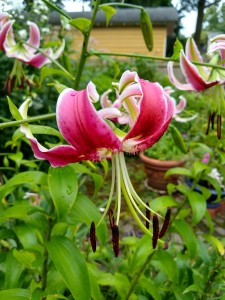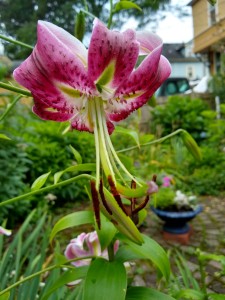
After all my years as a gardener, you would think that I could hang out the “no vacancy” sign over my beds and borders. But sometimes weak plants die and underperformers need relocation to more congenial spaces. Occasionally I swear that the groundhogs carry off choice specimens and replant them according to their own aesthetic sensibilities. Just the other day, a crocosmia popped up in the front border. I am not convinced that it was there originally.
For all of the above reasons, I currently have some blank spaces in my sunny garden beds. My neighbors, who have wisely invested in vast quantities of lilies, are now reveling in their beauty and fragrance. I am left to contemplate the incoming garden catalogs and think about ways of rectifying the lily situation and avoiding future midsummer garden doldrums.
The lilies that I covet for my garden are true lilies, members of the genus Lilium, rather than daylilies, which belong to the genus Hemerocallis. I have nothing but good things to say about daylilies, which flourish in just about every corner and bloom in an array of colors. But for the height, color and drama that I crave, I need their Lilium relatives.
Any new lilies will keep company with the relatively few specimens already in residence. In the back, a tall stand of ‘Black Beauty,’ lilies has resisted deer, weather and other assaults, and is about to unveil “Turk’s cap” blooms featuring back-swept petals of dark maroon with white edges. The plants grow at least five feet tall every year and six or more in really good years. The variety was introduced in 1957, and, having garnered universal admiration over a long period of time, merited induction into the North American Lily Society’s Hall of Fame.
Martha Stewart boasts of a mass planting of tiger lilies, known more formally as Lilium lancifolium ‘Splendens’. I have two plants, currently holding forth in the upper back garden. They are of similar stature to the ‘Black Beauty’ lilies, but feature orange Turk’s caps accented with brownish/maroon raised dots. Tiny bulblets form in the leaf axils and, if all goes well, fall to the ground and provide lucky gardeners with more tigers. Mine do seem disposed to do so, but like all cats they are undoubtedly fickle. I will work on their cultural conditions in the hopes of encouraging offspring for next year.
I am drawn to the flashy, extra-large, waxy flowers of the Oriental lilies, like Lilium auratum ‘Gold Band.’ Each of ‘Gold Band’s petals is striped with gold on the inside and speckled with tiny dark red spots. Originally from Japan, the lily is fragrant and prefers a bright sheltered spot with acid soil. When happy, it is glorious and grows up to four feet tall. I can certainly use a stand of ‘Gold Band’ to lift my spirits as the Shasta daisies fade. 
Not all early love affairs turn out well. This happened to me with the gorgeous regal Lily or lilium regale. Now I am ready to try again, on the theory that love is always sweeter the second time around. The golden-throated regals have the trumpet shape of a large Easter lily. The inside of each petal is white, but the outside is ribbed and brushed with distinctive burgundy and rose markings. Hyperbole is rampant in the world of horticulture, but I think it is not an overstatement to say that the scent of even one mature regal lily is intoxicating.
The great garden writer Beverly Nichols could not get enough of regal lilies in the early twentieth century and grew so many that he was able to bestow bouquets of them on his lucky friends in London café society. I do not have such flossy friends, so I won’t need quite so many regals. This will make it easier to afford the handful of bulbs that will adorn next summer’s garden.
Lilies love high, sunny corners and look lovely growing against walls. The big showy varieties that I currently covet often need staking, an idea that pains some people. Now that I have identified the current garden deficiencies, I think that the minimal cost and effort involved in staking will pay off in beauty and fragrance. After all, bamboo is cheap, but on a hot, sticky July day, inspiration is priceless.
If you share my affliction and don’t have enough lilies or simply want to increase or diversify your supply, try John Scheepers, 23 Tulip Drive, PO Box 638, Bantam, Connecticut 06750; (860) 567-0838; www.johnscheepers.com. The catalog is free. For heirloom varieties, contact Old House Gardens Heirloom Bulbs, 4175 Whitmore Lake Road, Ann Arbor, MI 48105; (734) 995-1486; www.oldhousegardens.com.
